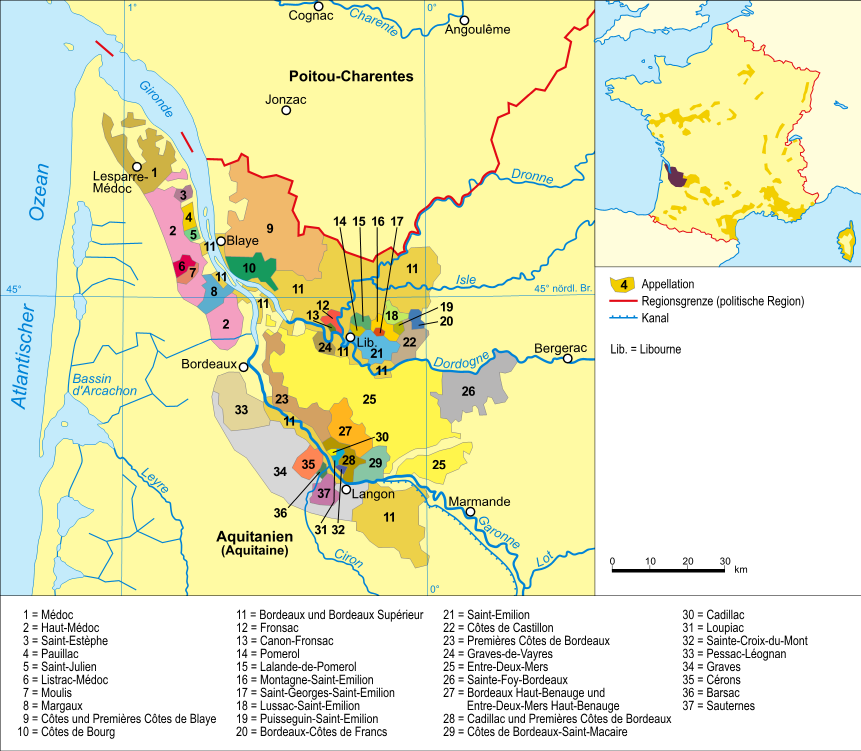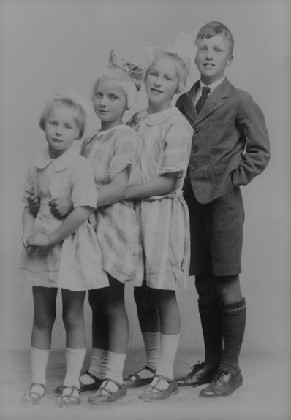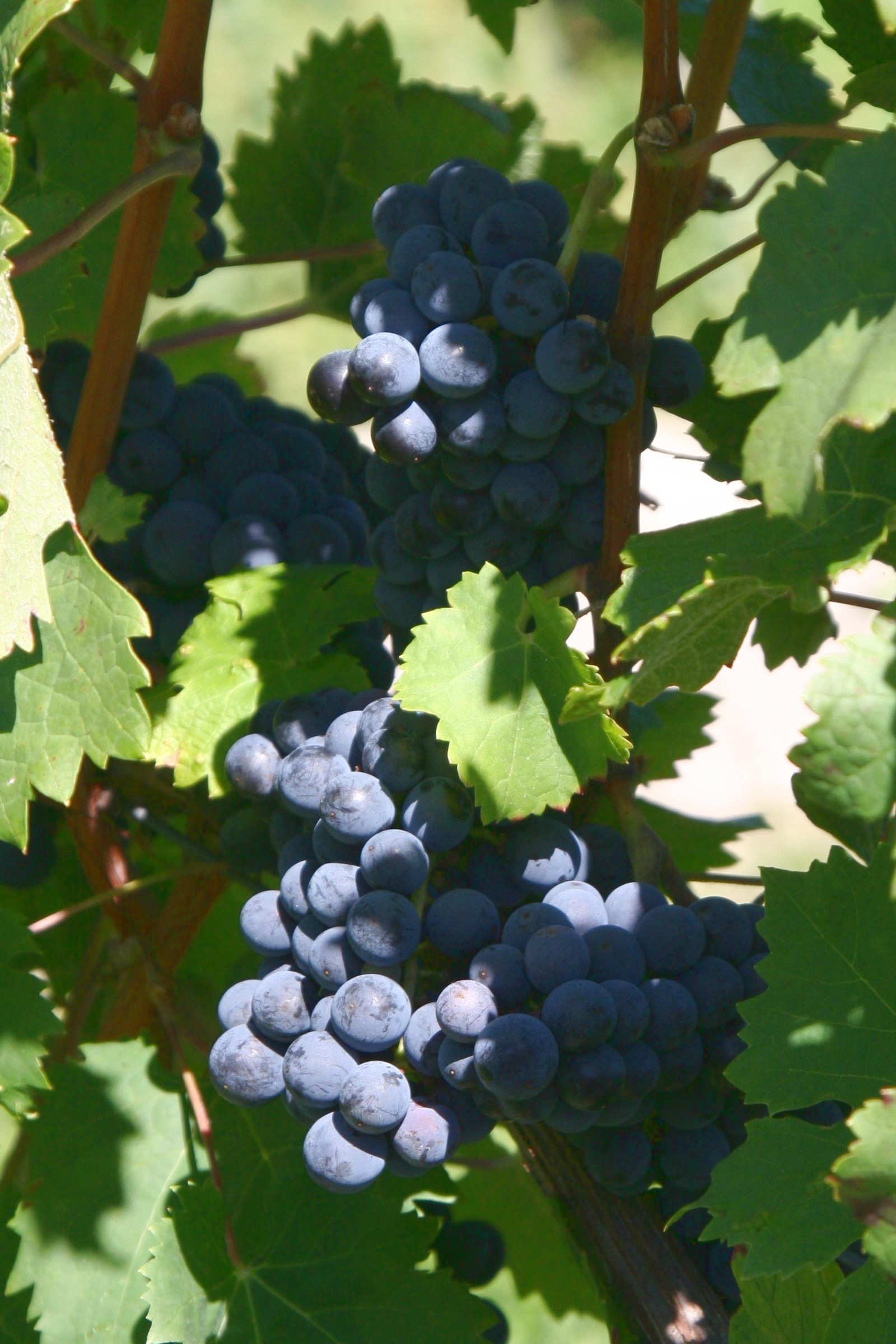|
Château Branaire-Ducru
Château Branaire is a winery in the Saint-Julien-Beychevelle, Saint-Julien Appellation d'Origine Contrôlée, appellation of the Bordeaux region of France. Château Branaire is also the name of the main red wine produced by this property and which was classified as one of the ten 'Fourth Growths' (Quatrièmes Crus) in the Bordeaux Wine Official Classification of 1855. Vineyard Although the actual château is located on the southern border of the appellation, across from Château Beychevelle, the vineyards of the estate are spread throughout Saint-Julien. In total, the vineyards cover 50 hectares (about 120 acres). The majority of plantings are devoted to Cabernet Sauvignon (70%), followed by Merlot (22%), Cabernet Franc (4%) and Petit Verdot (4%). The vines average 35 years of age and are harvested by hand. Wine Château Branaire produces two wines: * The grand vin Château Branaire (often referred to as Château Branaire Ducru) averages about 15,000 cases per year. Branair ... [...More Info...] [...Related Items...] OR: [Wikipedia] [Google] [Baidu] |
Cabernet Franc
Cabernet Franc is one of the major black grape varieties worldwide. It is principally grown for blending with Cabernet Sauvignon and Merlot in the Bordeaux (wine), Bordeaux style, but can also be vinified alone, as in the Loire (wine), Loire's Chinon wine, Chinon. In addition to being used in blends and produced as a varietal in Canada (wine), Canada, Lake Erie AVA, Lake Erie AVA in Pennsylvania, and across the United States (wine), United States and Argentina, it is sometimes made into ice wine in those regions. Cabernet Franc is lighter than Cabernet Sauvignon, making a bright pale red wine that contributes finesse and lends a Black pepper, peppery perfume to blends with more robust grapes. Depending on the growing region and style of wine, additional Aromas (wine), aromas can include tobacco, raspberry, bell pepper, Blackcurrant, cassis, and Viola (plant), violets. Records of Cabernet Franc in Bordeaux go back to the end of the 18th century, although it was planted in Loire ... [...More Info...] [...Related Items...] OR: [Wikipedia] [Google] [Baidu] |
Bordeaux Wine
Bordeaux wine (; ) is produced in the Bordeaux region of southwest France, around the city of Bordeaux, on the Garonne River. To the north of the city, the Dordogne River joins the Garonne forming the broad estuary called the Gironde; the Gironde department, with a total vineyard area of 110,800 hectares, is the second largest wine-growing area in France behind the Languedoc-Rousillon. Average vintages produce over 700 million bottles of wine, ranging from large quantities of daily table wine to some of the world's most expensive and prestigious wines. The vast majority of wine produced in Bordeaux is red (sometimes called "claret" in Britain), with sweet white wines (most notably Sauternes), dry whites, and (in much smaller quantities) rosé and sparkling wines ( Crémant de Bordeaux) collectively making up the remainder. Bordeaux wine is made by more than 5,660 producers or ''châteaux''. There are 65 appellations of Bordeaux wine. History Viticulture was introduce ... [...More Info...] [...Related Items...] OR: [Wikipedia] [Google] [Baidu] |
French Wine
French wine is produced throughout all of France in quantities between 50 and 60 million hectolitres per year, or 7–8 billion bottles. France is one of the largest wine producers in the world. French wine traces its history to the 6th century BCE, with many of France's regions dating their wine-making history to Roman times. The wines produced range from expensive wines sold internationally to modest wines usually only seen within France such as the Margnat wines of the post-war period. Two concepts central to the better French wines are the notion of ''terroir'', which links the style of the wines to the locations where the grapes are grown and the wine is made, and the Protected designation of origin (''Appellation d'Origine Protégée'', AOP) system, named ''Appellation d'origine contrôlée'' (AOC) until 2012. Appellation rules closely define which grape varieties and winemaking practices are approved for classification in each of France's several hundred ge ... [...More Info...] [...Related Items...] OR: [Wikipedia] [Google] [Baidu] |
Taste (short Story)
"Taste" is a short story by Roald Dahl that was first published in the December 8 1951 edition of ''The New Yorker'' and was included in the 1953 collection '' Someone Like You''. Plot summary There are six people eating a fine dinner at the house of Mike Schofield, a London stockbroker: Mike, his wife and daughter, an unnamed narrator and his wife, and a wine connoisseur, Richard Pratt. Pratt often makes small bets with Schofield to guess what wine is being served at the table, but during the night in the story he is uninterested, instead attempting to socialize with Schofield's eighteen-year-old daughter, Louise. When Schofield brings the second wine of the night he remarks that it will be impossible to guess where it is from, but Pratt takes that as a challenge. The tough talk on both sides leads the two to increase the bet until Pratt declares that he would like to bet for the hand of Schofield's daughter in marriage — if he loses, he will give Schofield both of his house ... [...More Info...] [...Related Items...] OR: [Wikipedia] [Google] [Baidu] |
Roald Dahl
Roald Dahl (13 September 1916 – 23 November 1990) was a British author of popular children's literature and short stories, a poet, screenwriter and a wartime Flying ace, fighter ace. His books have sold more than 300 million copies worldwide. He has been called "one of the greatest storytellers for children of the 20th century". Dahl was born in Wales to affluent Norwegians, Norwegian immigrant parents, and lived for most of his life in England. He served in the Royal Air Force (RAF) during the Second World War. He became a fighter pilot and, subsequently, an intelligence officer, rising to the rank of acting wing commander. He rose to prominence as a writer in the 1940s with works for children and for adults, and he became one of the world's best-selling authors. His awards for contribution to literature include the 1983 World Fantasy Award for Life Achievement and the Specsavers National Book Awards, British Book Awards' Children's Author of the Year in 1990. In 2 ... [...More Info...] [...Related Items...] OR: [Wikipedia] [Google] [Baidu] |
Second Wine
Second wine or second label (French: ''Second vin'') is a term commonly associated with Bordeaux wine to refer to a second label wine made from '' cuvee'' not selected for use in the ''Grand vin'' or first label. In some cases a third wine or even fourth wine is also produced. Depending on the house winemaking style, individual plots of a vineyard may be selected, often those of the youngest vines, and fermented separately, with the best performing barrels being chosen for the house's top wine and the other barrels being bottled under a separate label and sold for a lower price than the ''Grand vin''. In less favorable vintages, an estate may choose to release only a second label wine rather than to release a smaller than normal quantity of its ''Grand vin'' or a wine that would not be consistent with past vintages under that name. The practice has its roots in the 18th century but became more commercially prominent in the 1980s when consumers discovered these wines as a more ... [...More Info...] [...Related Items...] OR: [Wikipedia] [Google] [Baidu] |
Malolactic Fermentation
Malolactic conversion (also known as malolactic fermentation or MLF) is a process in winemaking in which Tart (flavor), tart-tasting malic acid, naturally present in grape must, is converted to softer-tasting lactic acid. Malolactic fermentation is most often performed as a secondary fermentation (wine), secondary fermentation shortly after the end of the primary fermentation (wine), fermentation, but can sometimes run concurrently with it. The process is standard for most red wine production and common for some white grape varieties such as Chardonnay, where it can impart a "buttery" flavor from diacetyl, a byproduct of the reaction. The fermentation reaction is undertaken by the family of lactic acid bacteria (LAB); ''Oenococcus oeni'', and various species of ''Lactobacillus'' and ''Pediococcus''. Chemically, malolactic fermentation is a decarboxylation, which means carbon dioxide is liberated in the process.K. Fugelsang, C. Edwards ''Wine Microbiology'' Second Edition pgs 29-44 ... [...More Info...] [...Related Items...] OR: [Wikipedia] [Google] [Baidu] |
Petit Verdot
Petit Verdot is a variety of red wine grape, principally used in classic Bordeaux blends. It ripens much later than the other varieties in Bordeaux, often too late, so it fell out of favour in its home region. When it does ripen it adds tannin, colour and flavour, in small amounts, to the blend. Petit verdot has attracted attention among winemakers in the New World, where it ripens more reliably and has been made into single varietal wine. It is also useful in 'stiffening' the mid palate of Cabernet Sauvignon blends. When young its aromas have been likened to banana and pencil shavings. Strong tones of violet and leather develop as it matures. History Petit Verdot probably predates Cabernet Sauvignon in Bordeaux, but its origins are unclear. There are records of it in the eighteenth century, but its characteristics suggest an origin in much hotter climes than the Gironde. It is likely that it originates from the Pyrénées-Atlantiques where it was possibly domesticated from ... [...More Info...] [...Related Items...] OR: [Wikipedia] [Google] [Baidu] |
Merlot
Merlot ( ) is a dark-blue-colored wine grape variety that is used as both a blending grape and for varietal wines. The name ''Merlot'' is thought to be a diminutive of , the French name for the blackbird, probably a reference to the color of the grape. Its softness and "fleshiness", combined with its earlier ripening, make Merlot a popular grape for blending with the sterner, later-ripening Cabernet Sauvignon, which tends to be higher in tannin. Along with Cabernet Sauvignon, Cabernet Franc, Malbec, and Petit Verdot, Merlot is one of the primary grapes used in Bordeaux wine, and it is the most widely planted grape in the Bordeaux wine regions. Merlot is also one of the most popular red wine varietals in many markets. This flexibility has helped to make it one of the world's most planted grape varieties. As of 2004, Merlot was estimated to be the third most grown variety at globally.J. Robinson (ed) ''The Oxford Companion to Wine'' Third Edition, Oxford University P ... [...More Info...] [...Related Items...] OR: [Wikipedia] [Google] [Baidu] |
Winery
A winery is a building or property that produces wine, or a business involved in the cultivation and production of wine, such as a wine company. Some wine companies own many wineries. Besides wine making equipment, larger wineries may also feature warehouses, bottling lines, laboratories, and large expanses of tanks known as tank farms. Wineries may have existed as long as 8,000 years ago. Ancient history The earliest known evidence of winemaking at a relatively large scale, if not evidence of actual wineries, has been found in the Middle East. In 2011 a team of archaeologists discovered a 6000 year old wine press in a cave in the Areni region of Armenia, and identified the site as a small winery. Previously, in the northern Zagros Mountains in Iran, jars over 7000 years old were discovered to contain tartaric acid crystals (a chemical marker of wine), providing evidence of winemaking in that region. Archaeological excavations in the southern Georgian region of Kvemo Kartli ... [...More Info...] [...Related Items...] OR: [Wikipedia] [Google] [Baidu] |
Cabernet Sauvignon
Cabernet Sauvignon () is one of the world's most widely recognized red wine grape varieties. It is grown in nearly every major wine producing country among a diverse spectrum of climates from Australia and British Columbia, Canada to Lebanon's Beqaa Valley. This grape variety appeared in France in the 17th century as a result of natural crossbreeding. Its popularity is often attributed to its ease of cultivation—the grapes have thick skins and the vines are hardy and naturally low yielding, budding late to avoid frost and resistant to viticulture hazards. The classic profile of Cabernet Sauvignon tends to be full-bodied wines with high tannins and noticeable acidity that contributes to the wine's aging potential. In cool areas, it has flavors of blackcurrant and green pepper; in warmer places, it may taste like black cherry and olive; in very hot climates, it can have a jammy flavor. History and origins For many years, the origin of Cabernet Sauvignon was not cl ... [...More Info...] [...Related Items...] OR: [Wikipedia] [Google] [Baidu] |




